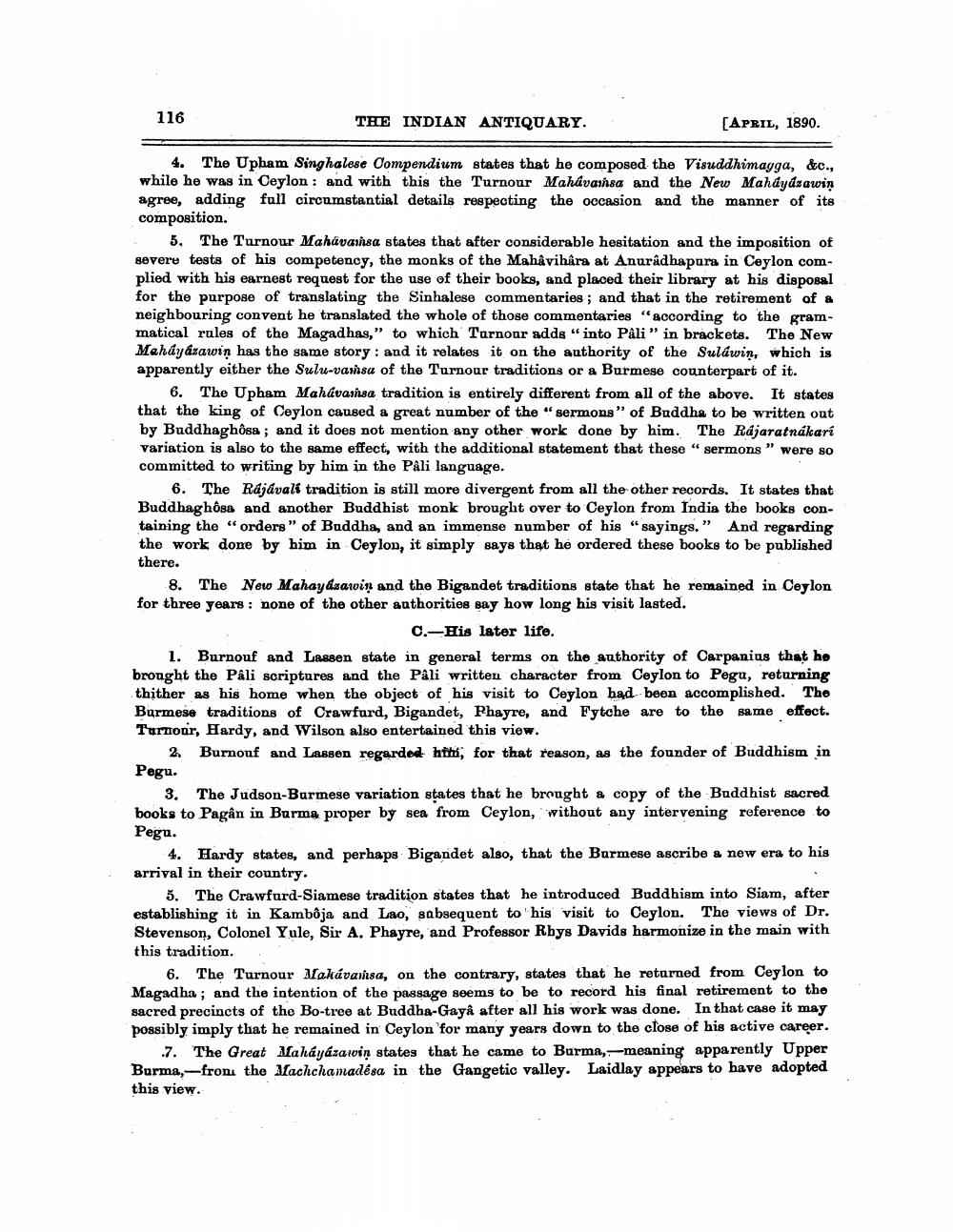________________
116
THE INDIAN ANTIQUARY.
[APRIL, 1890.
4. The Upham Singhalese Compendium states that he composed the Visuddhimayga, &c., while he was in Ceylon: and with this the Turnour Mahávansa and the New Mahdydrawin agree, adding full circumstantial details respecting the occasion and the manner of its composition.
5. The Turnour Mahavainsa states that after considerable hesitation and the imposition of severe tests of his competency, the monks of the Mahâvihara at Anuradhapura in Ceylon complied with his earnest request for the use of their books, and placed their library at his disposal for the purpose of translating the Sinhalese commentaries ; and that in the retirement of a neighbouring convent he translated the whole of those commentaries "according to the grammatical rules of the Magadhas," to which Turnour adds" into PAli" in brackets. The New Mahdyázawin has the same story: and it relates it on the authority of the Sulawin, which is apparently either the Sulu-vansa of the Turnour traditions or a Burmese counterpart of it.
6. The Upham Mahavainsa tradition is entirely different from all of the above. It states that the king of Ceylon caused a great number of the "sermons" of Buddha to be written out by Buddhaghosa ; and it does not mention any other work done by him. The Rajaratnákari variation is also to the same effect, with the additional statement that these " sermons" were so committed to writing by him in the PAli language.
6. The Rájávali tradition is still more divergent from all the other records. It states that Buddhaghôss and another Buddhist monk brought over to Ceylon from India the books containing the “orders" of Buddha, and an immense number of his "sayings.” And regarding the work done by him in Ceylon, it simply says that he ordered these books to be published there.
8. The New Mahay dzawin and the Bigandet traditions state that he remained in Ceylon for three years: none of the other authorities say how long his visit lasted.
C.-His later life. 1. Burnouf and Lassen state in general terms on the authority of Carpanius that he brought the Pali scriptures and the Pali written character from Ceylon to Pegu, returning thither as his home when the object of his visit to Ceylon had been accomplished. The Burmese traditions of Crawford, Bigandet, Phayre, and Fytche are to the same effect. Turnoor, Hardy, and Wilson also entertained this view.
2 Burnouf and Lassen regarded hth, for that reason, as the founder of Buddhism in Pegu.
3. The Judson-Burmese variation states that he brought a copy of the Buddhist sacred books to Pagan in Burma proper by sea from Ceylon, without any intervening reference to Pegu.
4. Hardy states, and perhaps Bigandet also, that the Burmese ascribe a new era to his arrival in their country.
5. The Crawfurd-Siamese tradition states that he introduced Buddhism into Siam, after establishing it in Kambôja and Lao, sabsequent to his visit to Ceylon. The views of Dr. Stevenson, Colonel Yule, Sir A. Phayre, and Professor Rhys Davids harmonize in the main with this tradition. .
6. The Turnour Makávainsa, on the contrary, states that he returned from Ceylon to Magadha; and the intention of the passage seems to be to record his final retirement to the sacred precincts of the Bo-tree at Buddha-Gayå after all his work was done. In that case it may possibly imply that he remained in Ceylon for many years down to the close of his active career.
.7. The Great Maháyázawin states that he came to Burma,-meaning apparently Upper Burma,-fron the Machchamadésa in the Gangetic valley. Laidlay appears to have adopted this view.




